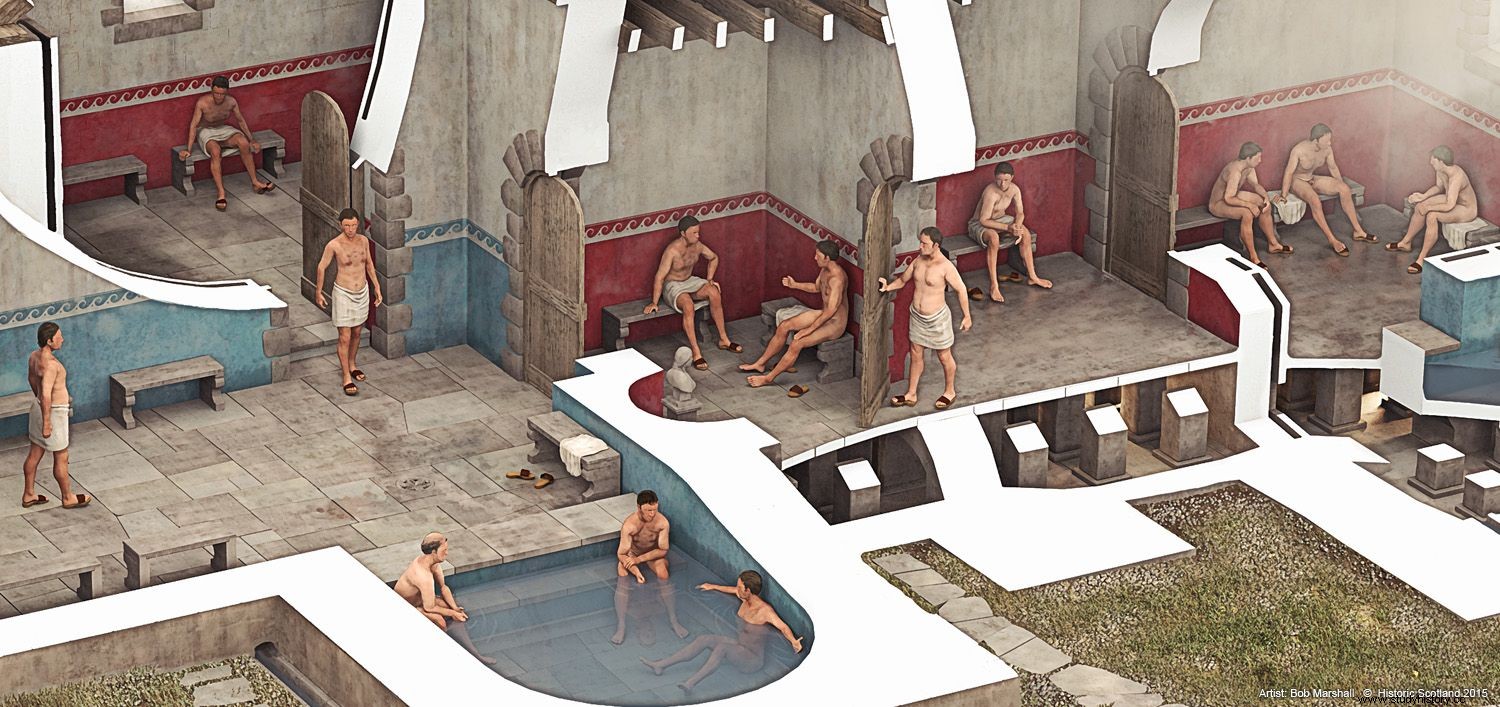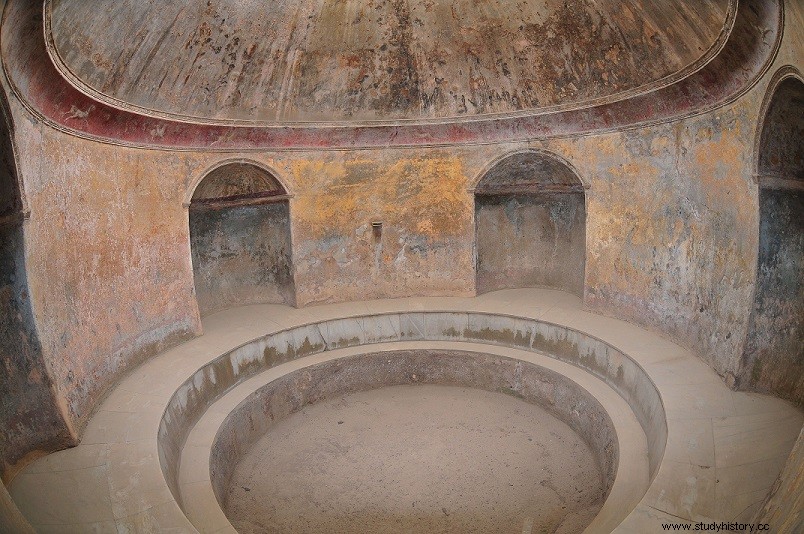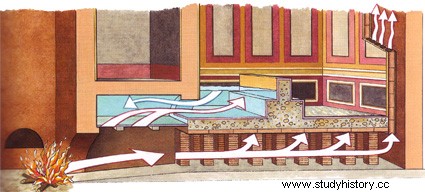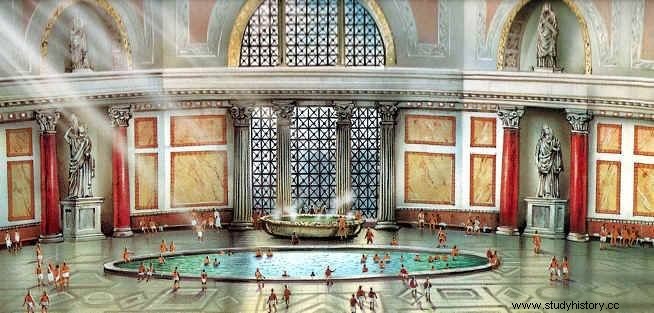Account Elio Esparciano in Augusta History (4th century) regarding the emperor Hadrian that «he bathed frequently in public and mingling with everyone. For this reason, that bathroom joke became famous:on one occasion when he saw a veteran whom he had known in the army rubbing his back and the rest of his body against the wall, he asked him why he scratched himself. the marble and, when he heard that he acted like this because he had no slave, he gave him slaves and money to support them. Instead, another day, when a crowd of old men were rubbing against the wall in order to provoke generosity from him, he ordered them to come before him and then scratch each other mutually ».

There is a lot of topic in the public baths of Ancient Rome. Like many other cultural achievements, the idea is not properly Roman, but Greek. It is true that in classical Greece there were no baths in use, but there were spaces dedicated to the cult of the body and its correct molding and hygiene, such as stadiums, exercise arenas and worship centers associated with the therapeutic properties of water. The baths do not take on their public and popular dimension until a much more pragmatic nation than the scattered Greeks assumes hegemony in the Mare Nostrum. The first baths were much more austere and simple than the images of the great imperial baths that many of us have in mind. In principle they consisted of a small hall where the slaves in charge of collection and maintenance attended to the clients. That small hall gave way to a changing room, a small rectangular room full of niches in its walls and a bench running under them for customers to undress and leave their belongings safely. A full bath in Caesar's time could cost between a couple of aces or a sestertius (depending on the place and the attention). From the locker room you went to the hot room (caldarium ), where a small rectangular bathtub with access steps on one of its long sides was used for the first dive. Near said bathtub was the font (patena ) in which a stream of fresh water was used to drink and cool off. The atmosphere in this room was quite suffocating as it was near the oven that kept the water in the room hot. We can still see this type of primitive baths in Pompeii and Valentia (Valencia).

Pompeii Baths
The classic republican and high-imperial baths brought a substantial change to the previous enclosure. The floor is not scale mosaic, but rather baked clay and is supported by brick pillars, between which hot air circulates from the little oven room (praefurnium ) This hot air distribution system between the walls and floors of the hot springs through pipes, designed by the brilliant engineer Cayo Sergio Orata , became very popular with Roman architects and is known as a hypocaust (the glory of my people). The oven equally heats the water in the caldarium bath, the "sauna" then called laconicum , and acts as central heating throughout the building. Such was the heat given off by the ground that many rented wooden sandals to avoid stepping barefoot and getting burned.

Hypocaust
In large cities a large bathtub (natatio was included ) in the cold room (frigidarium ), the equivalent of our outdoor swimming pools, where the last restorative cold bath was taken after sweating, exfoliating the skin with a sharp sickle-shaped instrument (strigilus) and massaging it with aromatic oils - this is the part the slave should do that the veteran did not have-.

Of course, already in the times of the Empire, the degree of popular attention to these enclosures multiplied and the architects and designers of these highly demanded public spaces began to exploit the thermal resources of mother nature and dress them in marble and porphyry. This is the case of the baths of Bath, where the thermal spring is used to supply hot and medicinal water to the swimming pool. The great crisis of the classical world also affected the baths. When the imperial treasury of the provinces was emptied due to the serious economic problems that shook the Empire from the second half of the 3rd century, many public buildings were abandoned. This is the case of the thermal baths of Caesaraugusta (Zaragoza), others were destroyed during the Germanic invasions and were not rebuilt (Valentia), or were simply consumed after the total abandonment of the city (Lucentum, Alicante). With the great megalomaniacs came the great venues. Trajan, Caracalla or Diocletian erected true monuments. The baths went from being a small neighborhood bath to wash and talk placidly among fellow citizens to lavish palaces of noble stones, full of luxuries, statuary, corridors, hundreds of slaves, different rooms with all kinds of baths, as well as attached and complementary businesses. to satisfy all the appetites of the clients; libraries, taverns and brothels came together in harmony in these "spas" of ancient Rome.

We have a good example of the evolution of the baths in a letter sent by the Cordovan Seneca to Lucilius , where he compares those of the times of Scipio Africanus (3rd century BC) with those of his time in the 1st century BC. C.
[…] I was struck by the contrast with the place used for the bathrooms. It was small, narrow, dark, according to ancient custom:it had to be a dark place; if not, our ancestors didn't think it was hot enough. It occurred to me to think of the great difference in customs that exists between ours and those of the time of Scipio. […] To people the baths seem poor and dilapidated if their walls do not shine with large and splendid mirrors; they claim that the walls are decorated with marbles from Alexandria and that they are inlaid with stones from Numidia; everywhere there must appear an elaborate and varied interweaving of varnishes in the manner of painting; the entire chamber must be covered with glass; our pools must be richly decorated throughout with Thasio precious stones. And that in some places, like swimming pools, where we leave all the bad moods of our body after having sweated a lot. Another of the whims in the decoration is that water spills over people from silver vases. How many statues, how many columns that don't support anything, but are put up just for decoration, just so people know how rich they are! How much water cascades noisily from step to step! We are getting used to a series of luxuries and extravagance and we are no longer satisfied with anything. In this Scipio bathroom there are hardly any gaps in the walls. Only a few small windows that are cut into the stone wall in such a way that they admit light without any problem or protection. The current bathrooms have to have large windows through which sunlight can enter throughout the day; that way, people will be doing two things at the same time:bathing and tanning. They can also dedicate themselves to other pleasures, such as admiring the landscape. From the place where you are sitting, you will see both the fields and the sea. According to people, if they do not meet these requirements, they are bathrooms more typical of cockroaches than of people. […]
In the past, public baths were few and had no decoration:why should a place be decorated that hardly cost an ace to enter and that was dedicated to necessary use and not to fun? The water did not spill from below nor did it run constantly renewed as if it came out of a hot spring, nor did they think they had to worry about the transparency of a water that they were going to dirty. But, oh gods, what would it help to enter those dark baths, decorated with vulgar stuccoes, if you knew that Cato, or Fabius Maximus, or one of the Cornelians when they were aediles, had heated the water for you with his own hand? Well, these most noble mayors fulfilled their obligation to enter these places that welcomed the people, and demanded cleanliness and a useful and healthy temperature of the water and environment, not like the one now that is similar to a fire, in such a way that it seems the most appropriate to wash alive a slave convicted of some crime. It seems to me that you no longer see the difference between a fiery or a hot bath. […] There are some who say:«I don't envy Scipio, because if he washed himself like that, it's as if he lived in exile». I don't know what they will think if they find out that, in addition, they did not bathe every day:according to what the ancient customs of the city have left us, every day they washed their arms and legs, which had become stained and had picked up a lot of dirt in field work; the complete bathroom was done on market days. After hearing this, it will occur to someone to say:"I think they were dirty." But what do you think they smelled like? His smell was that of soldiers, of work in the fields, of men. After clean and splendid toilets have been achieved, people are dirtier...
The hot springs collect the flavor of the Old World. Open from noon to dusk, they established female and male shifts (only a few mixed baths are known in Rome itself). There was more politics in the stillness of those bathtubs than in the chairs of the Curia, and the ladies found out about everything that was happening in their city only by frequently attending the baths. At the exit of the hot springs there was always a tavern where you could toast the businesses closed or the conspiracies undertaken.
